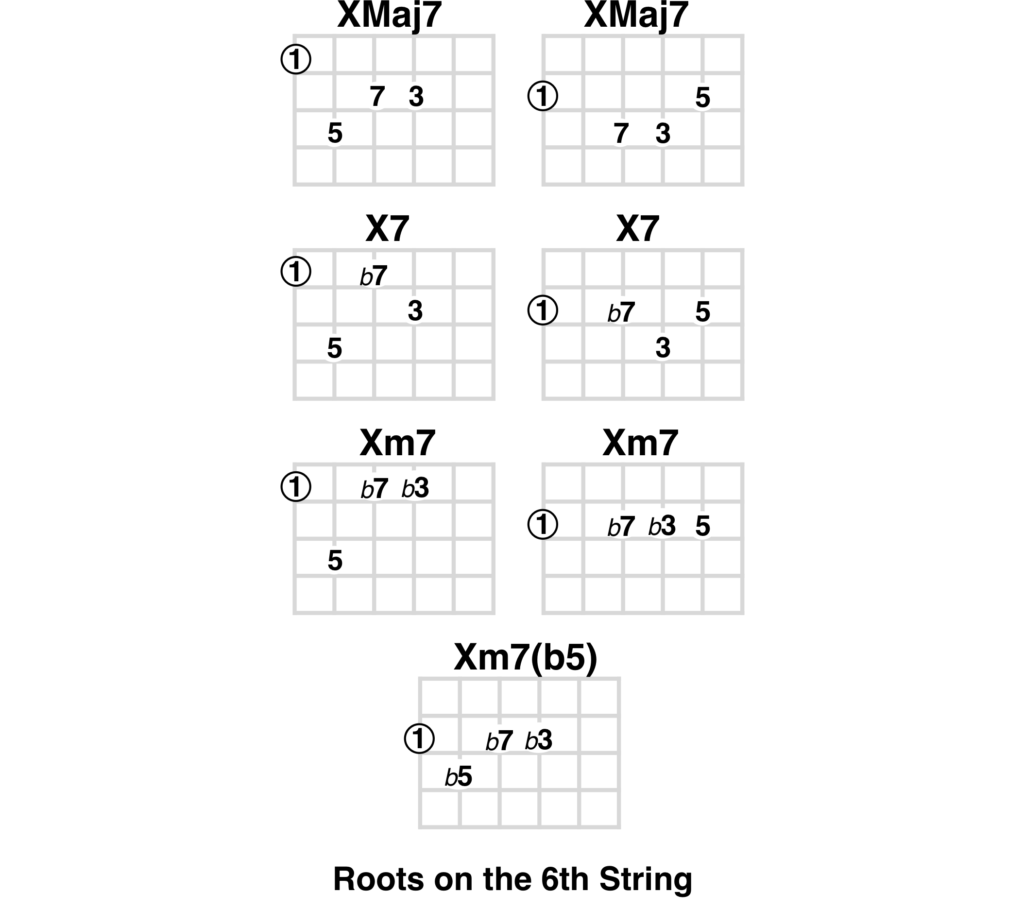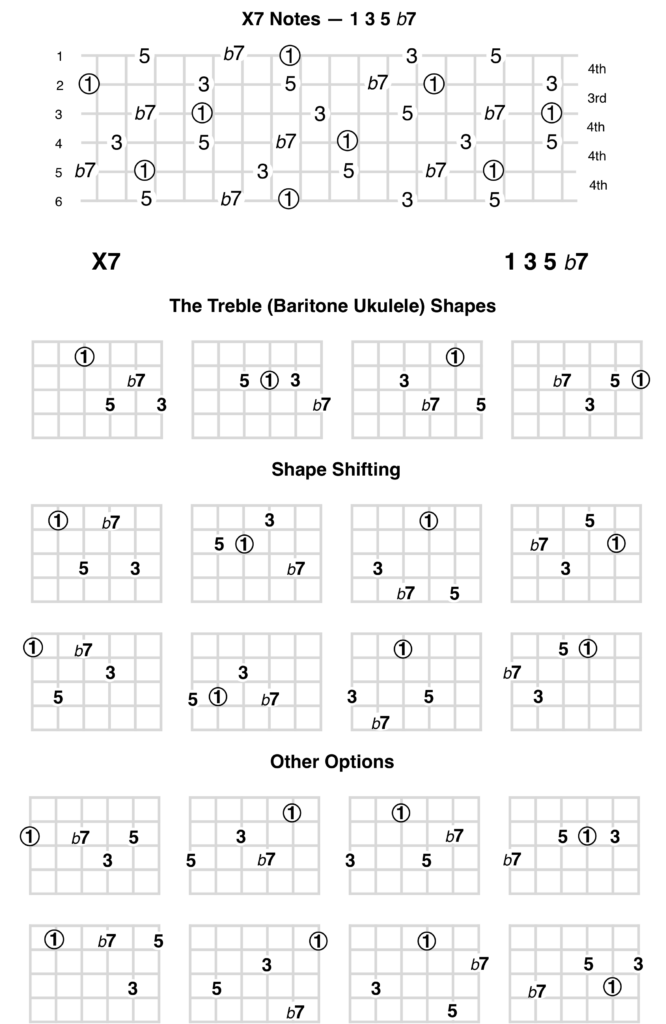1 – Introduction – This book builds on what was covered in Jazz Chords for Baritone Ukulele. The introduction from that book is included here, as it explains the basic ideas of the hows and whys of chords.
2 – Scales and Chords – Likewise, the concepts of scales and chords are the same for both baritone ukulele and guitar, so that chapter is included as well.
3 – Shape Shifting – Moving to six strings, the four note chords on the treble strings can be shifted to the middle and bass strings.

4 – Chord Scale Theory – Chord scales can be confusing. Read the whole chapter here to understand why the Major 7th, 7th, minor 7th, and minor 7th flat 5 are the essential seventh chords.
5 – Bass Voice Families – There are many voices available for playing seventh chords. Three of those voices, with the root on the bass notes of the chord, are used as examples throughout the book. One fret changes can morph any shape across the fretboard to any of the essential seventh chords. Below is the diagram illustrating the idea for the 1-5-7-3 family of chords.

6 – Chord Scale Practice – Ways to play chord scales with different chord families and different sets of strings. Here’s the 1-5-7-3 family playing a chord scale with the bass notes on the A string.

7 – Chord Progressions – Given the number of ways to play a chord, and the number of places to play a progression, this chapter separates the ingredients of progressions from the recipes. The recipes map the root movement on the fretboard. The ingredients organize the chords according to the string the root appears on. The figures below show the ingredients for chords with the root on the sixth string, the recipes for the simplest V -> I chord progression, and the samples for that progression.



8 – Intervals – This chapter was taken from Jazz Chords for Baritone Ukulele and explains how to look at chords as stacked intervals. Among other things it tries to sort out the confusion between moving between a 1 and a 5 and the intervals named a fifth and a fourth.

9 – Pythagoras – This chapter is also taken from Jazz Chords for Baritone Ukulele and explains how Pythagoras invented our musical scale and discovered the small integer ratios that define the most important intervals.

10 – Circle of Fifths – The Circle of Fifths is explained and illustrated with a number of different ways to play it using the different chord voice families. Here it is using the 1-7-3-5 family with the bass alternating between the E and A strings.


11 – Essential Sevenths Songs – Three jazz classics that can be accompanied almost entirely with essential sevenths chords, Fly me to The Moon, The Girl from Ipanema and I’ve Got Rhythm. Here’s a Bossa Nova strum and one option for the chords of the A1&2 sections of The Girl from Ipanema.


12 – Major and Minor Triads – Diagrams for triads and suggestions for how to combine them to get four note chords.
13 – 6ths – This chapter shows how to derive 6th chords from 7th chords, and which ones will sound well in a chord scale.
14 – Extended and Altered – This is a short chapter just explaining the difference between chords with additional notes, extended, or ones with their notes changed, altered. (That was pretty much the whole chapter.)
15 – Augmented and Suspended – Examples of altered chords and how to derive them from the the essential seventh chords.

16 – 9th 11th and 13th – Examples of these extensions and how best to come up with shapes for playing them. Here’s a diagram showing all the variations on 9th chords in one place.

17 – Fancier Songs – The book finishes with chord shapes for four more classic jazz songs, Summertime, Take Five, Stormy Monday and Bewitched Bothered and Bewildered. These songs all take advantage of the chord variations discussed in the previous chapters. Enjoy playing this twelve bar blues song, Stormy Monday. Listen to both T-Bone Walker and the Allmand Brothers versions of it on YouTube.

18 – Shape Library – The book includes a large library of possible shapes (fingering) for each of 41 different jazz chords. The classics are all included as well as chords such as an X13(b9) and XMaj7#11. Here’s a sample from that library for the basic 7th chord. Each diagram has a display of the notes on the fretboard, which can be used for single note soloing, and chord shapes for how the four voices for a chord, as played on the treble strings, can be shifted to the middle and bass strings.

